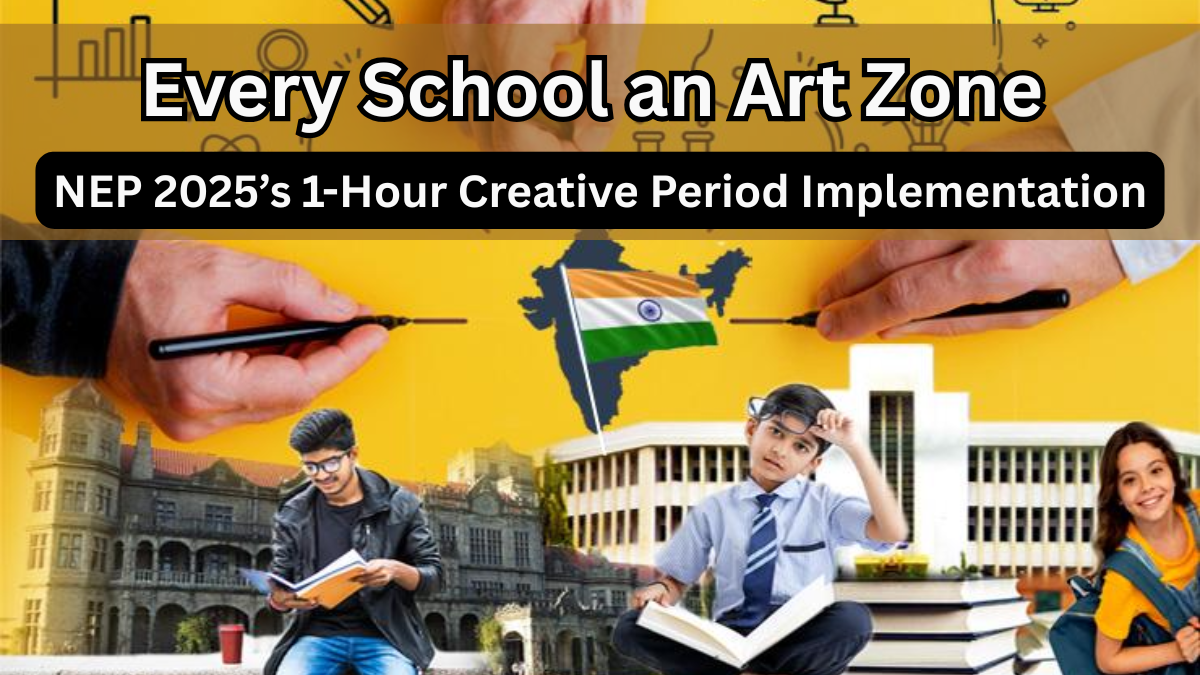The National Education Policy (NEP) 2025 has set a transformative vision for India’s education system. One of the most exciting initiatives is the introduction of a 1-hour daily creative period in schools, making art an integral part of students’ lives.
The focus on arts is not just about painting or music; it’s about fostering imagination, critical thinking, and emotional intelligence in every child. Here’s everything you need to know about NEP art period schools 2025 and school art education in India.

NEP 2025 and the Creative Period: A Snapshot
Under the NEP 2025 framework:
-
Every student will have a 1-hour dedicated art period daily.
-
Schools will include visual arts, music, theatre, dance, and crafts as part of the curriculum.
-
The initiative aims to blend academic learning with creativity, allowing children to express themselves and develop diverse skills.
-
Teachers will receive training in creative pedagogy to ensure the effectiveness of these sessions.
| Feature | Details |
|---|---|
| Duration | 1 hour per school day |
| Activities | Drawing, painting, music, dance, drama, crafts |
| Objective | Foster creativity, critical thinking, and emotional growth |
| Implementation | Across all recognized schools in India by 2025 |
Why NEP Art Period Schools 2025 Matters
Incorporating art in daily school life brings multiple benefits:
-
Enhances cognitive skills – Engaging in creative activities improves problem-solving, memory, and analytical thinking.
-
Promotes emotional well-being – Art allows students to express feelings and reduce stress.
-
Encourages inclusivity – Every child, regardless of academic strengths, can participate and excel in art.
-
Strengthens cultural identity – Learning traditional art forms connects students with India’s rich heritage.
By making every school a mini art hub, school art education in India is moving toward a more balanced and holistic approach to learning.
How Schools Can Implement the NEP Art Period
Successful implementation requires careful planning. Here’s a step-by-step guide:
-
Curriculum Design – Integrate arts with core subjects and allow flexibility for different mediums.
-
Teacher Training – Upskill teachers in creative pedagogy and ensure regular workshops.
-
Infrastructure Setup – Equip schools with art rooms, music instruments, craft materials, and digital tools.
-
Monitoring & Assessment – Evaluate creativity through projects, performances, and portfolios rather than conventional exams.
| Step | Action Point | Outcome |
|---|---|---|
| Curriculum | Daily 1-hour art sessions | Integrated creative learning |
| Teachers | Training programs & workshops | Skilled art educators |
| Infrastructure | Art studios & materials | Hands-on creative experiences |
| Assessment | Project-based evaluation | Holistic student growth |
Challenges and Solutions
Implementing NEP’s creative period may face obstacles:
-
Limited resources – Many schools may struggle with infrastructure or materials.
-
Solution: Collaboration with local artists and NGOs for workshops.
-
-
Teacher readiness – Not all teachers are trained in arts.
-
Solution: Government-led professional development programs.
-
-
Balancing academics and arts – Academic pressure may reduce focus on art.
-
Solution: Integrate creative periods seamlessly into the school timetable.
-
FAQs
Q1: Are all schools in India required to implement the 1-hour art period under NEP 2025?
Yes, the policy mandates that recognized schools incorporate the daily creative period to enhance holistic education.
Q2: What types of art activities can students expect in this hour?
Students will engage in drawing, painting, music, dance, theatre, and traditional crafts to explore different creative avenues.
Q3: How will teachers be prepared for NEP art period schools 2025?
Teachers will receive specialized training and workshops to handle creative sessions effectively, fostering student growth.
Q4: Will this initiative impact academic learning in other subjects?
No, the creative period complements academics by boosting cognitive skills, emotional well-being, and problem-solving abilities.
Click here to learn more
